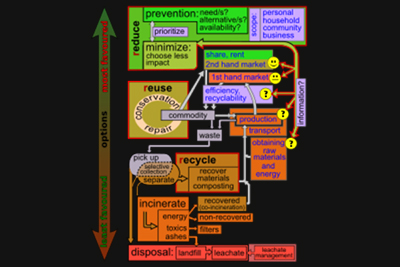Replace Landfill Based Infrastructure with an Integrated Waste Management System to Move Toward a Circular Economy
Replace Landfill Based Infrastructure with an Integrated Waste Management System to Move Toward a Circular Economy
Project: Develop an Integrated Waste Management System to Build Toward a Circular Economy.
“In the fight against global warming, protecting our environment and moving towards a Circular Economy, this is one of the most critical and important programs of IeRM” P. Schmidt-Pathmann, CEO
Question: Why does it matter?
Answer: Landfilling is the least sustainable method of managing waste. The practice reduces reuse and recycling, buries valuable materials, causes the release of harmful toxics into the air and water, and creates a financial and environmental liability for future generations. The hidden costs of landfilling untreated municipal solid and similar wastes are exponential. Please also see our Projects ‘Methane Testing at Landfills’ & ‘Identify & Account for the True Cost of Landfilling’.
Background: Landfilling has been society’s primary way of dealing with waste for thousands of years. When the population was small and mobile, the practice was simple, as there were few concerns about environmental impacts, raw materials, long term care and few or no alternatives. As cities grew, however, the amount of waste became much larger and an ever-growing number of toxics in the waste stream has made landfilling of municipal solid waste completely unable to deal with the negative environmental impacts. There are also many hidden costs that the consumer is unaware of. In the past few decades with changing material use in manufacturing, other concerns have arisen, such as the waste of valuable resources. Today, opponents of landfilling raise three valid objections:
1) Landfills are significant sources of pollution. They emit methane, a potent greenhouse gas, as well as other harmful and toxic gases. Methane collection systems reduce but cannot eliminate methane releases. They also release toxic substances in runoff (called leachate), which can have a detrimental effect on groundwater.
2) Landfills reduce efforts at recycling and reusing materials. The USEPA and other environmental agencies have documented that much of what goes into landfills today could actually be recycled or reused. In addition, energy and valuable materials could be recovered from waste through an advanced thermal recovery process. Reuse and recovery would reduce the demand for virgin materials, such as wood, glass, metals, and petroleum.
3) Landfills create an invisible tax on the public, due to the need to mitigate the environmental impacts described above and the need to manage the landfill in perpetuity, long after it has been closed.
Solution: An Integrated Waste Management System (IWMS), based on the principles of the internationally recognized waste management hierarchy, prioritizes (in order) avoidance or reduction, reuse, recycling and composting, and recovery (of energy and secondary raw materials like metals, glass, HCL, gypsum, aggregate). Following this hierarchy removes the need to send anything but a small amount of inert materials to the landfill. Each of these steps will require a change in the way things are done. For example, avoidance or reduction can require businesses to reduce packaging or (as some communities have done) eliminate plastic bags. Reuse can be encouraged through product stewardship, as has been done with electronic waste. Recycling can be greatly improved through source separation (where the waste is produced), as well as the redesign of containers and packaging from mixed to single materials. Finding substitutes for plastic, such as compostable plant-based materials, will also contribute.
Changing to a new, integrated system will not be easy. Society has become used to a disposable regime, and many businesses are dependent on this continuing. The process must be carefully managed and explained, with clearly articulated goals and public involvement. A well-planned and implemented IWMS will enable an accelerated move toward a circular economy, with long-term environmental and economic benefits.
In order to reduce harmful greenhouse gases, increase reuse, recycling and recovery efforts, create valuable jobs and eliminate the “invisible tax” that everyone pays for when landfilling waste we need your support in moving to an IWMS.
Collectively, the IeRM Team has the unique and necessary experience to implement the IWMS.
Please make a tax-deductible contribution to IeRM to support this critical work.

